HI6008 Research Proposal: Analyzing Big Data in Business Organizations
VerifiedAdded on 2023/06/12
|18
|4282
|385
Report
AI Summary
This research proposal investigates the use of Big Data in business organizations, focusing on its potential to optimize resource storage, reduce computation time, and improve decision-making. It includes a literature review summarizing key aspects of Big Data, its goals, data mining techniques, applications, and frameworks. The proposal also addresses the challenges associated with Big Data implementation, identifies a research gap, and presents research questions to guide the study. Furthermore, it outlines the research design and methodology, detailing both qualitative and quantitative approaches, along with research limitations and a time schedule for the project. The proposal concludes by emphasizing the importance of understanding Big Data's role in contemporary business environments and the potential benefits and drawbacks of its application.
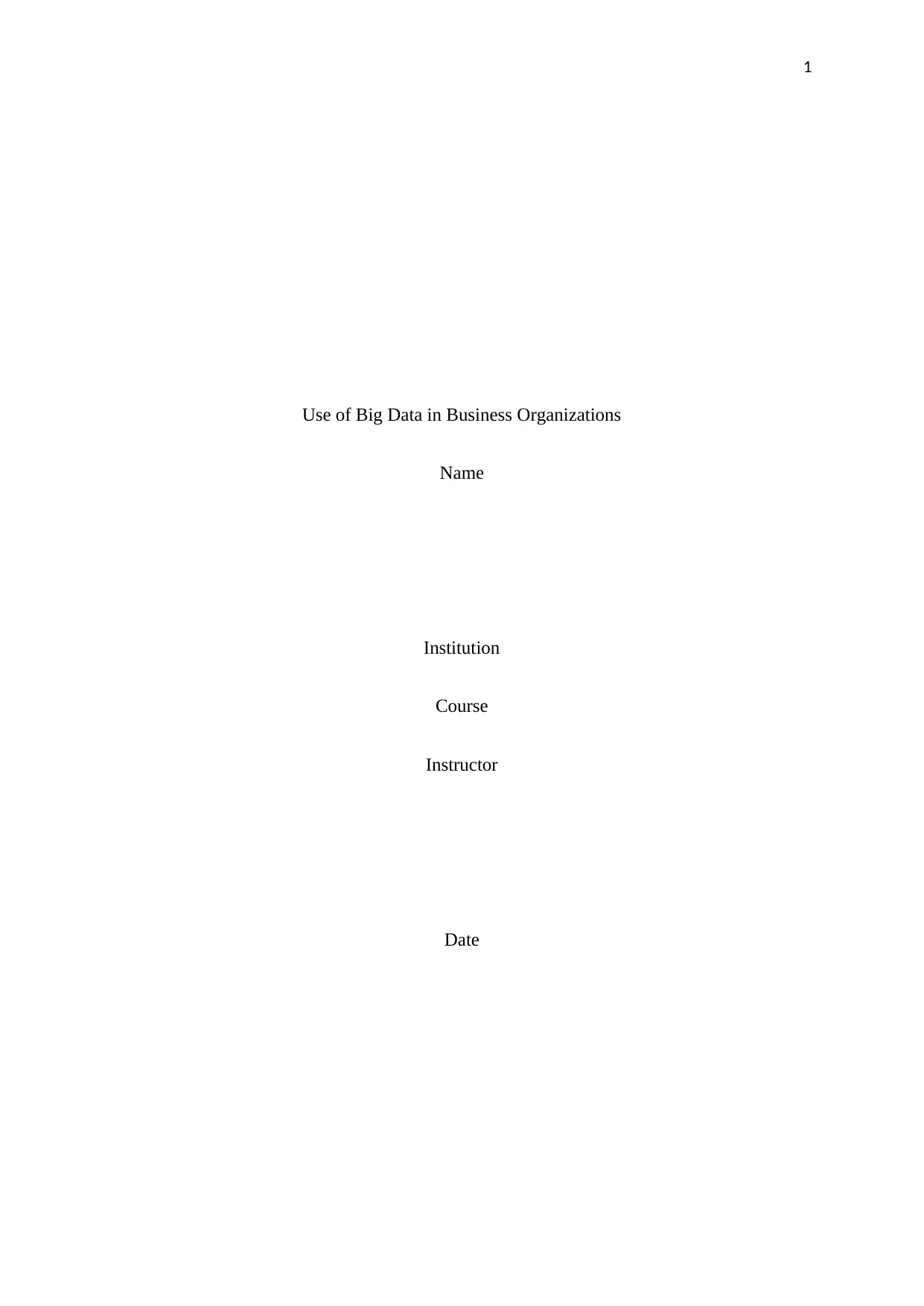
1
Use of Big Data in Business Organizations
Name
Institution
Course
Instructor
Date
Use of Big Data in Business Organizations
Name
Institution
Course
Instructor
Date
Paraphrase This Document
Need a fresh take? Get an instant paraphrase of this document with our AI Paraphraser
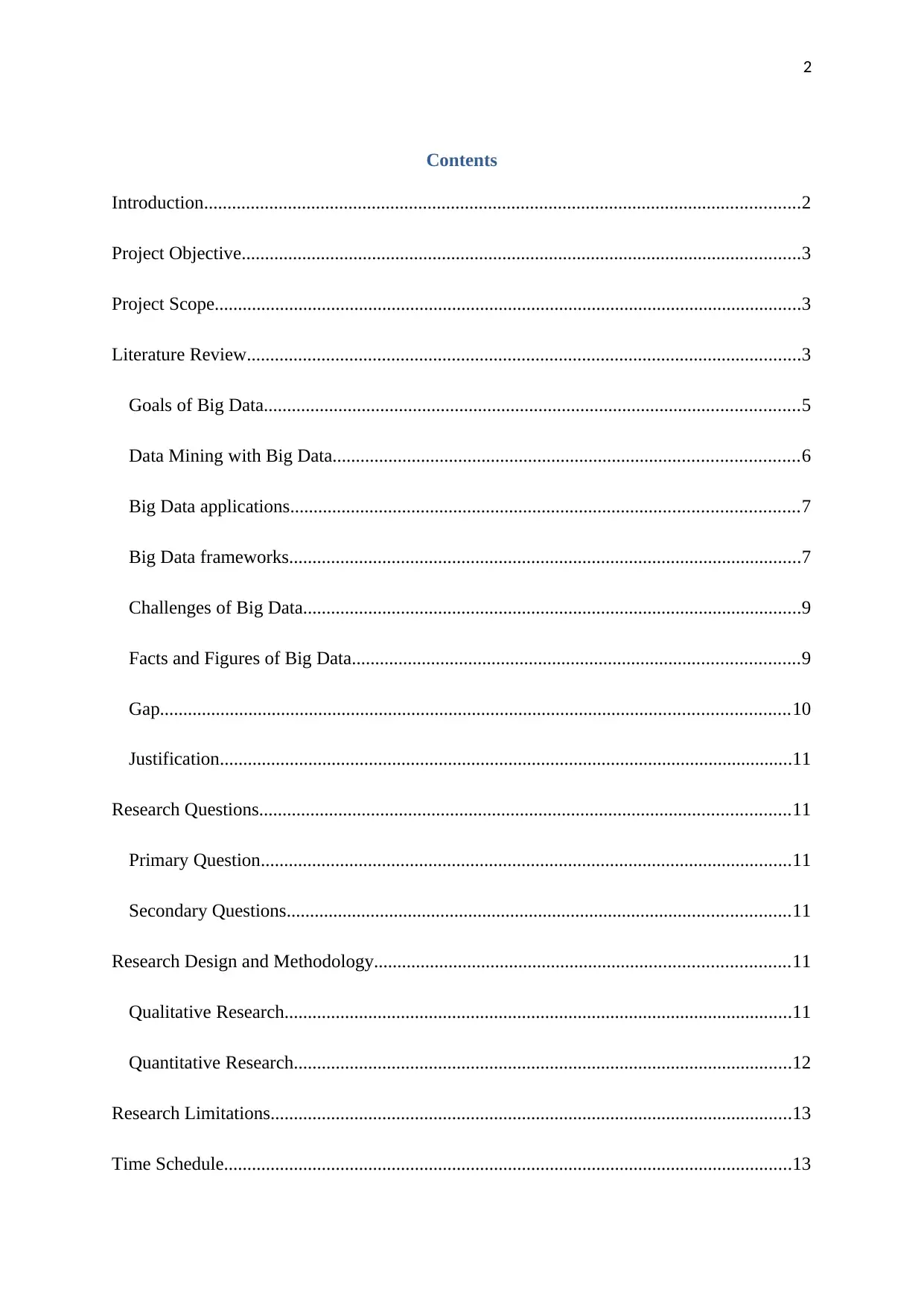
2
Contents
Introduction................................................................................................................................2
Project Objective........................................................................................................................3
Project Scope..............................................................................................................................3
Literature Review.......................................................................................................................3
Goals of Big Data...................................................................................................................5
Data Mining with Big Data....................................................................................................6
Big Data applications.............................................................................................................7
Big Data frameworks..............................................................................................................7
Challenges of Big Data...........................................................................................................9
Facts and Figures of Big Data................................................................................................9
Gap.......................................................................................................................................10
Justification...........................................................................................................................11
Research Questions..................................................................................................................11
Primary Question..................................................................................................................11
Secondary Questions............................................................................................................11
Research Design and Methodology.........................................................................................11
Qualitative Research.............................................................................................................11
Quantitative Research...........................................................................................................12
Research Limitations................................................................................................................13
Time Schedule..........................................................................................................................13
Contents
Introduction................................................................................................................................2
Project Objective........................................................................................................................3
Project Scope..............................................................................................................................3
Literature Review.......................................................................................................................3
Goals of Big Data...................................................................................................................5
Data Mining with Big Data....................................................................................................6
Big Data applications.............................................................................................................7
Big Data frameworks..............................................................................................................7
Challenges of Big Data...........................................................................................................9
Facts and Figures of Big Data................................................................................................9
Gap.......................................................................................................................................10
Justification...........................................................................................................................11
Research Questions..................................................................................................................11
Primary Question..................................................................................................................11
Secondary Questions............................................................................................................11
Research Design and Methodology.........................................................................................11
Qualitative Research.............................................................................................................11
Quantitative Research...........................................................................................................12
Research Limitations................................................................................................................13
Time Schedule..........................................................................................................................13

3
Conclusion................................................................................................................................14
Reference List..........................................................................................................................15
Appendix..................................................................................................................................17
Conclusion................................................................................................................................14
Reference List..........................................................................................................................15
Appendix..................................................................................................................................17
⊘ This is a preview!⊘
Do you want full access?
Subscribe today to unlock all pages.

Trusted by 1+ million students worldwide
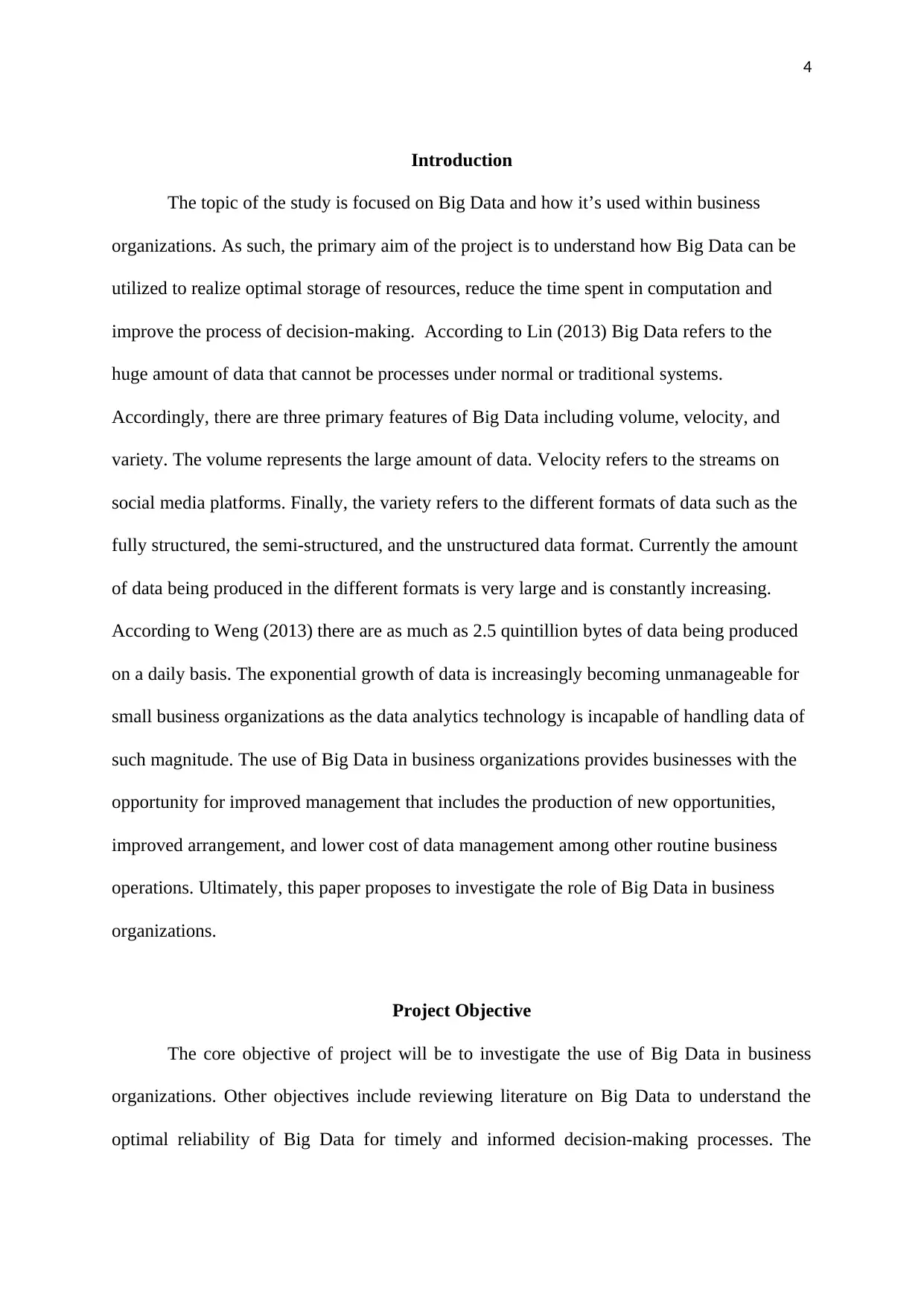
4
Introduction
The topic of the study is focused on Big Data and how it’s used within business
organizations. As such, the primary aim of the project is to understand how Big Data can be
utilized to realize optimal storage of resources, reduce the time spent in computation and
improve the process of decision-making. According to Lin (2013) Big Data refers to the
huge amount of data that cannot be processes under normal or traditional systems.
Accordingly, there are three primary features of Big Data including volume, velocity, and
variety. The volume represents the large amount of data. Velocity refers to the streams on
social media platforms. Finally, the variety refers to the different formats of data such as the
fully structured, the semi-structured, and the unstructured data format. Currently the amount
of data being produced in the different formats is very large and is constantly increasing.
According to Weng (2013) there are as much as 2.5 quintillion bytes of data being produced
on a daily basis. The exponential growth of data is increasingly becoming unmanageable for
small business organizations as the data analytics technology is incapable of handling data of
such magnitude. The use of Big Data in business organizations provides businesses with the
opportunity for improved management that includes the production of new opportunities,
improved arrangement, and lower cost of data management among other routine business
operations. Ultimately, this paper proposes to investigate the role of Big Data in business
organizations.
Project Objective
The core objective of project will be to investigate the use of Big Data in business
organizations. Other objectives include reviewing literature on Big Data to understand the
optimal reliability of Big Data for timely and informed decision-making processes. The
Introduction
The topic of the study is focused on Big Data and how it’s used within business
organizations. As such, the primary aim of the project is to understand how Big Data can be
utilized to realize optimal storage of resources, reduce the time spent in computation and
improve the process of decision-making. According to Lin (2013) Big Data refers to the
huge amount of data that cannot be processes under normal or traditional systems.
Accordingly, there are three primary features of Big Data including volume, velocity, and
variety. The volume represents the large amount of data. Velocity refers to the streams on
social media platforms. Finally, the variety refers to the different formats of data such as the
fully structured, the semi-structured, and the unstructured data format. Currently the amount
of data being produced in the different formats is very large and is constantly increasing.
According to Weng (2013) there are as much as 2.5 quintillion bytes of data being produced
on a daily basis. The exponential growth of data is increasingly becoming unmanageable for
small business organizations as the data analytics technology is incapable of handling data of
such magnitude. The use of Big Data in business organizations provides businesses with the
opportunity for improved management that includes the production of new opportunities,
improved arrangement, and lower cost of data management among other routine business
operations. Ultimately, this paper proposes to investigate the role of Big Data in business
organizations.
Project Objective
The core objective of project will be to investigate the use of Big Data in business
organizations. Other objectives include reviewing literature on Big Data to understand the
optimal reliability of Big Data for timely and informed decision-making processes. The
Paraphrase This Document
Need a fresh take? Get an instant paraphrase of this document with our AI Paraphraser
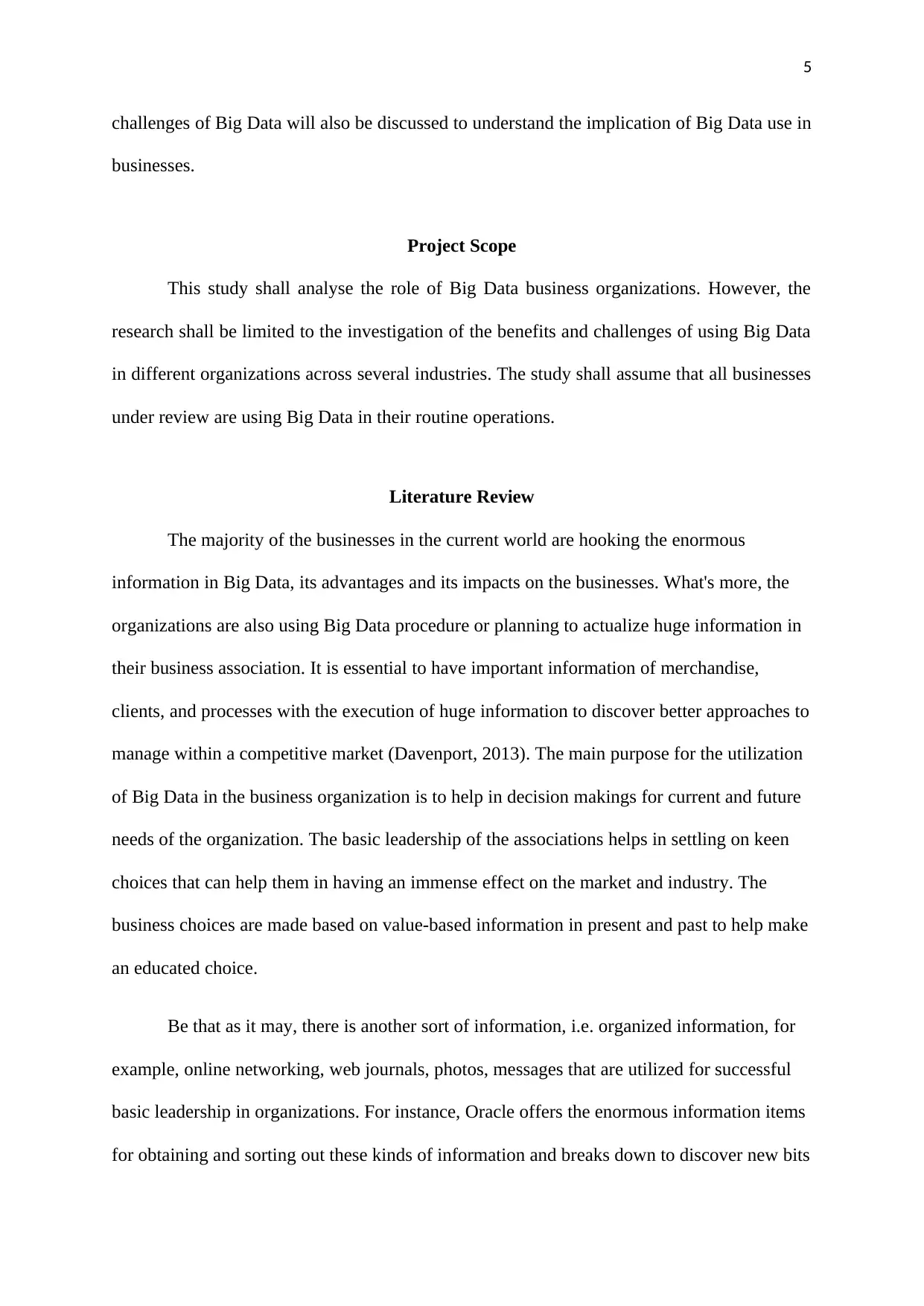
5
challenges of Big Data will also be discussed to understand the implication of Big Data use in
businesses.
Project Scope
This study shall analyse the role of Big Data business organizations. However, the
research shall be limited to the investigation of the benefits and challenges of using Big Data
in different organizations across several industries. The study shall assume that all businesses
under review are using Big Data in their routine operations.
Literature Review
The majority of the businesses in the current world are hooking the enormous
information in Big Data, its advantages and its impacts on the businesses. What's more, the
organizations are also using Big Data procedure or planning to actualize huge information in
their business association. It is essential to have important information of merchandise,
clients, and processes with the execution of huge information to discover better approaches to
manage within a competitive market (Davenport, 2013). The main purpose for the utilization
of Big Data in the business organization is to help in decision makings for current and future
needs of the organization. The basic leadership of the associations helps in settling on keen
choices that can help them in having an immense effect on the market and industry. The
business choices are made based on value-based information in present and past to help make
an educated choice.
Be that as it may, there is another sort of information, i.e. organized information, for
example, online networking, web journals, photos, messages that are utilized for successful
basic leadership in organizations. For instance, Oracle offers the enormous information items
for obtaining and sorting out these kinds of information and breaks down to discover new bits
challenges of Big Data will also be discussed to understand the implication of Big Data use in
businesses.
Project Scope
This study shall analyse the role of Big Data business organizations. However, the
research shall be limited to the investigation of the benefits and challenges of using Big Data
in different organizations across several industries. The study shall assume that all businesses
under review are using Big Data in their routine operations.
Literature Review
The majority of the businesses in the current world are hooking the enormous
information in Big Data, its advantages and its impacts on the businesses. What's more, the
organizations are also using Big Data procedure or planning to actualize huge information in
their business association. It is essential to have important information of merchandise,
clients, and processes with the execution of huge information to discover better approaches to
manage within a competitive market (Davenport, 2013). The main purpose for the utilization
of Big Data in the business organization is to help in decision makings for current and future
needs of the organization. The basic leadership of the associations helps in settling on keen
choices that can help them in having an immense effect on the market and industry. The
business choices are made based on value-based information in present and past to help make
an educated choice.
Be that as it may, there is another sort of information, i.e. organized information, for
example, online networking, web journals, photos, messages that are utilized for successful
basic leadership in organizations. For instance, Oracle offers the enormous information items
for obtaining and sorting out these kinds of information and breaks down to discover new bits
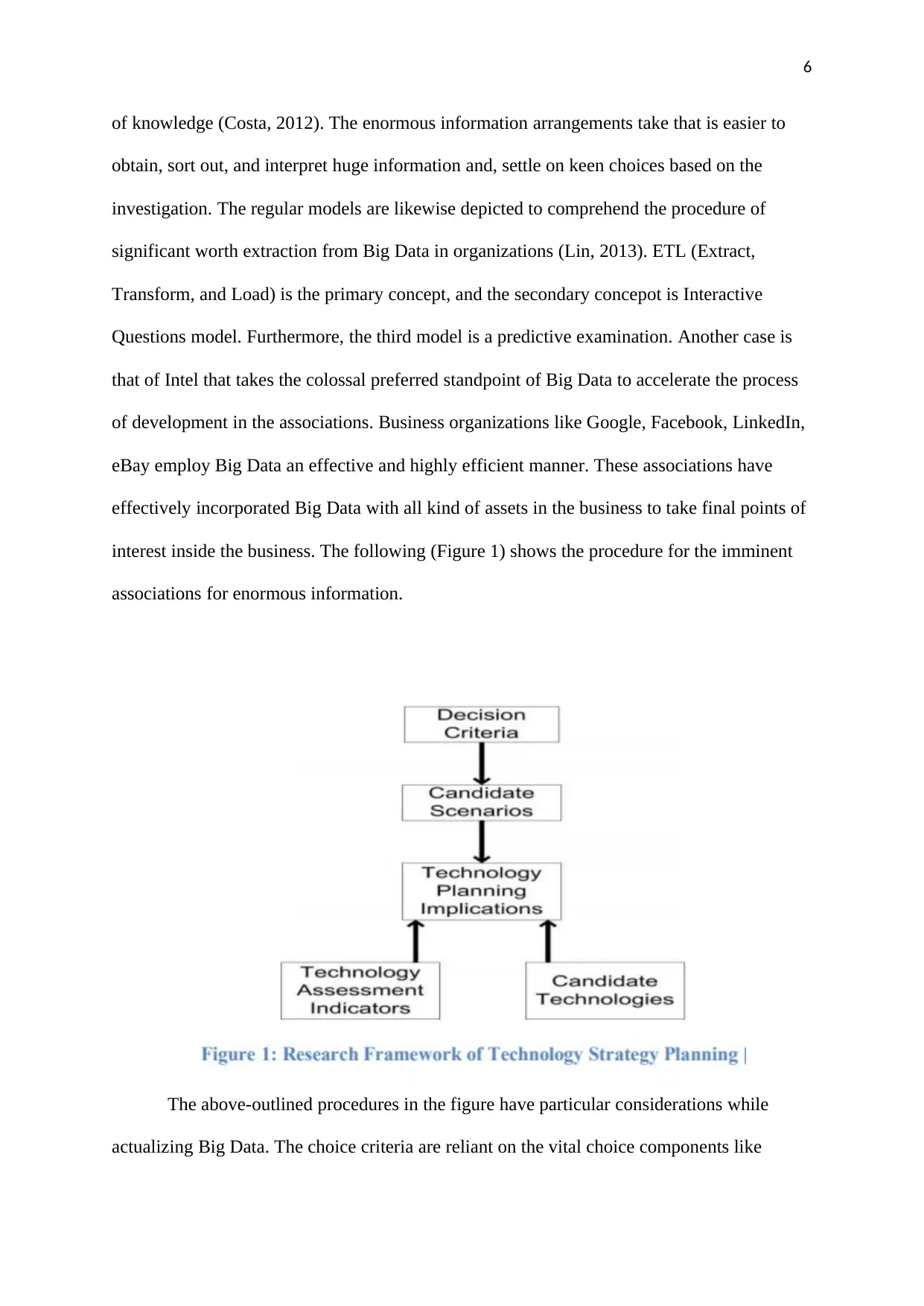
6
of knowledge (Costa, 2012). The enormous information arrangements take that is easier to
obtain, sort out, and interpret huge information and, settle on keen choices based on the
investigation. The regular models are likewise depicted to comprehend the procedure of
significant worth extraction from Big Data in organizations (Lin, 2013). ETL (Extract,
Transform, and Load) is the primary concept, and the secondary concepot is Interactive
Questions model. Furthermore, the third model is a predictive examination. Another case is
that of Intel that takes the colossal preferred standpoint of Big Data to accelerate the process
of development in the associations. Business organizations like Google, Facebook, LinkedIn,
eBay employ Big Data an effective and highly efficient manner. These associations have
effectively incorporated Big Data with all kind of assets in the business to take final points of
interest inside the business. The following (Figure 1) shows the procedure for the imminent
associations for enormous information.
The above-outlined procedures in the figure have particular considerations while
actualizing Big Data. The choice criteria are reliant on the vital choice components like
of knowledge (Costa, 2012). The enormous information arrangements take that is easier to
obtain, sort out, and interpret huge information and, settle on keen choices based on the
investigation. The regular models are likewise depicted to comprehend the procedure of
significant worth extraction from Big Data in organizations (Lin, 2013). ETL (Extract,
Transform, and Load) is the primary concept, and the secondary concepot is Interactive
Questions model. Furthermore, the third model is a predictive examination. Another case is
that of Intel that takes the colossal preferred standpoint of Big Data to accelerate the process
of development in the associations. Business organizations like Google, Facebook, LinkedIn,
eBay employ Big Data an effective and highly efficient manner. These associations have
effectively incorporated Big Data with all kind of assets in the business to take final points of
interest inside the business. The following (Figure 1) shows the procedure for the imminent
associations for enormous information.
The above-outlined procedures in the figure have particular considerations while
actualizing Big Data. The choice criteria are reliant on the vital choice components like
⊘ This is a preview!⊘
Do you want full access?
Subscribe today to unlock all pages.

Trusted by 1+ million students worldwide
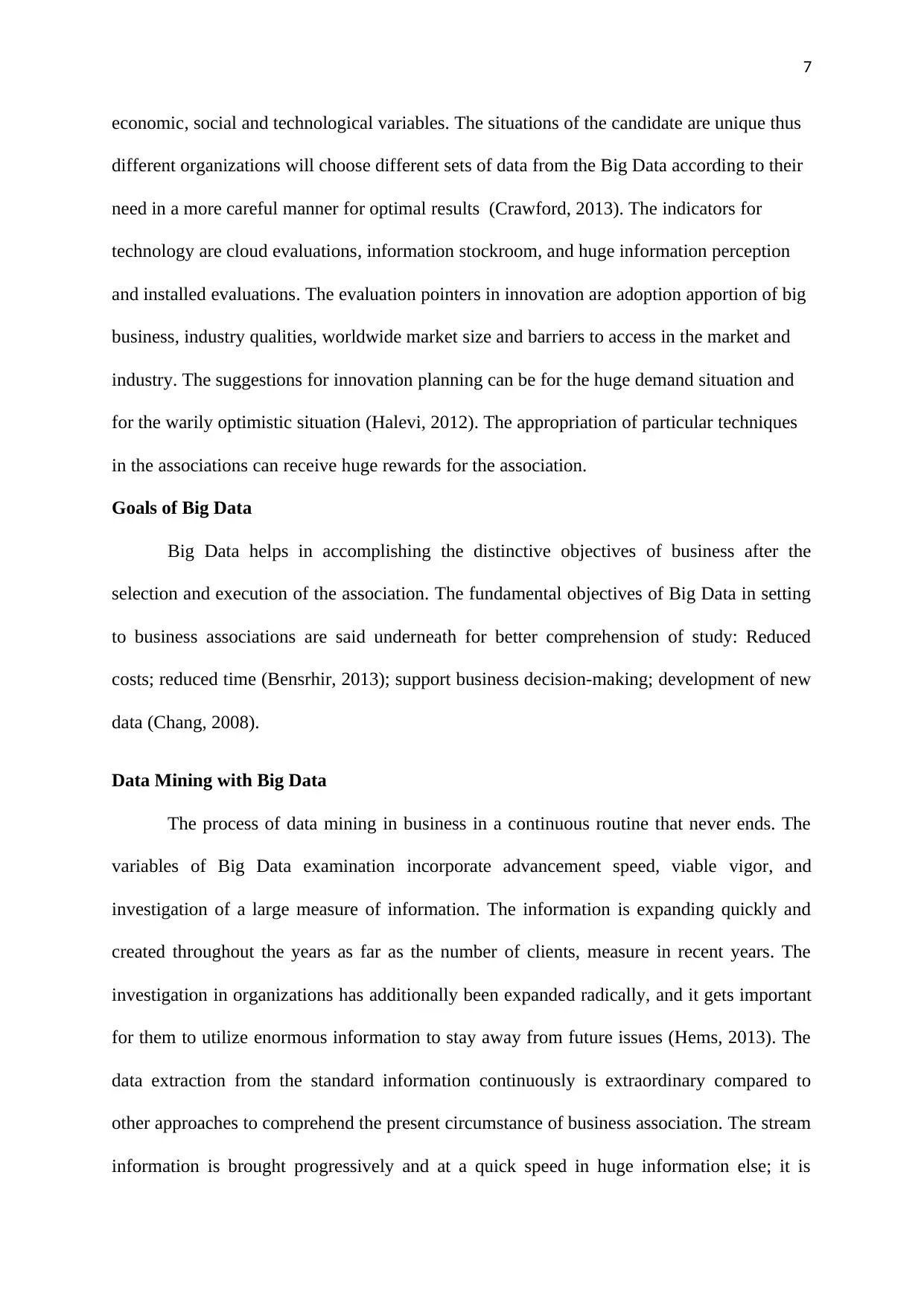
7
economic, social and technological variables. The situations of the candidate are unique thus
different organizations will choose different sets of data from the Big Data according to their
need in a more careful manner for optimal results (Crawford, 2013). The indicators for
technology are cloud evaluations, information stockroom, and huge information perception
and installed evaluations. The evaluation pointers in innovation are adoption apportion of big
business, industry qualities, worldwide market size and barriers to access in the market and
industry. The suggestions for innovation planning can be for the huge demand situation and
for the warily optimistic situation (Halevi, 2012). The appropriation of particular techniques
in the associations can receive huge rewards for the association.
Goals of Big Data
Big Data helps in accomplishing the distinctive objectives of business after the
selection and execution of the association. The fundamental objectives of Big Data in setting
to business associations are said underneath for better comprehension of study: Reduced
costs; reduced time (Bensrhir, 2013); support business decision-making; development of new
data (Chang, 2008).
Data Mining with Big Data
The process of data mining in business in a continuous routine that never ends. The
variables of Big Data examination incorporate advancement speed, viable vigor, and
investigation of a large measure of information. The information is expanding quickly and
created throughout the years as far as the number of clients, measure in recent years. The
investigation in organizations has additionally been expanded radically, and it gets important
for them to utilize enormous information to stay away from future issues (Hems, 2013). The
data extraction from the standard information continuously is extraordinary compared to
other approaches to comprehend the present circumstance of business association. The stream
information is brought progressively and at a quick speed in huge information else; it is
economic, social and technological variables. The situations of the candidate are unique thus
different organizations will choose different sets of data from the Big Data according to their
need in a more careful manner for optimal results (Crawford, 2013). The indicators for
technology are cloud evaluations, information stockroom, and huge information perception
and installed evaluations. The evaluation pointers in innovation are adoption apportion of big
business, industry qualities, worldwide market size and barriers to access in the market and
industry. The suggestions for innovation planning can be for the huge demand situation and
for the warily optimistic situation (Halevi, 2012). The appropriation of particular techniques
in the associations can receive huge rewards for the association.
Goals of Big Data
Big Data helps in accomplishing the distinctive objectives of business after the
selection and execution of the association. The fundamental objectives of Big Data in setting
to business associations are said underneath for better comprehension of study: Reduced
costs; reduced time (Bensrhir, 2013); support business decision-making; development of new
data (Chang, 2008).
Data Mining with Big Data
The process of data mining in business in a continuous routine that never ends. The
variables of Big Data examination incorporate advancement speed, viable vigor, and
investigation of a large measure of information. The information is expanding quickly and
created throughout the years as far as the number of clients, measure in recent years. The
investigation in organizations has additionally been expanded radically, and it gets important
for them to utilize enormous information to stay away from future issues (Hems, 2013). The
data extraction from the standard information continuously is extraordinary compared to
other approaches to comprehend the present circumstance of business association. The stream
information is brought progressively and at a quick speed in huge information else; it is
Paraphrase This Document
Need a fresh take? Get an instant paraphrase of this document with our AI Paraphraser
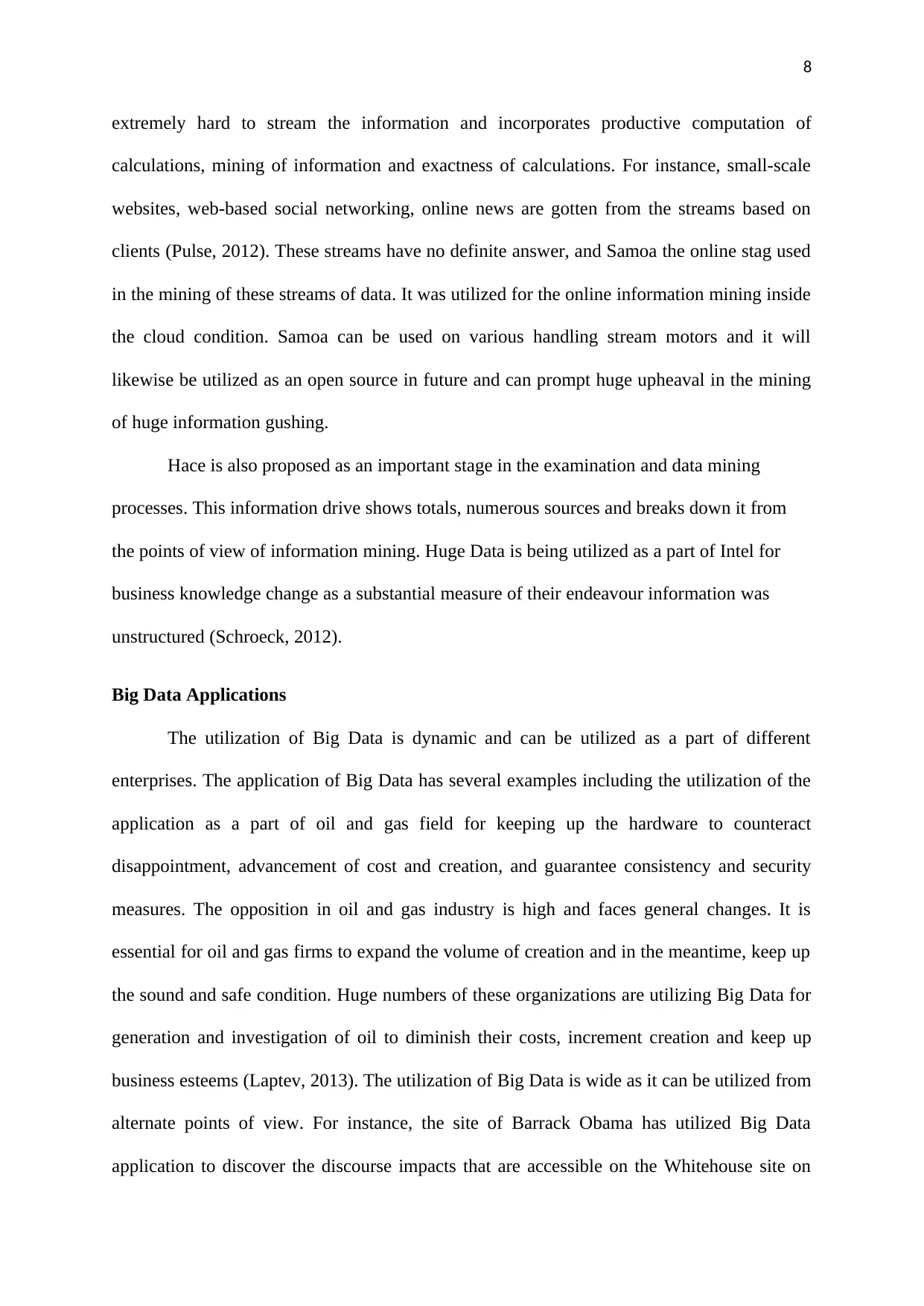
8
extremely hard to stream the information and incorporates productive computation of
calculations, mining of information and exactness of calculations. For instance, small-scale
websites, web-based social networking, online news are gotten from the streams based on
clients (Pulse, 2012). These streams have no definite answer, and Samoa the online stag used
in the mining of these streams of data. It was utilized for the online information mining inside
the cloud condition. Samoa can be used on various handling stream motors and it will
likewise be utilized as an open source in future and can prompt huge upheaval in the mining
of huge information gushing.
Hace is also proposed as an important stage in the examination and data mining
processes. This information drive shows totals, numerous sources and breaks down it from
the points of view of information mining. Huge Data is being utilized as a part of Intel for
business knowledge change as a substantial measure of their endeavour information was
unstructured (Schroeck, 2012).
Big Data Applications
The utilization of Big Data is dynamic and can be utilized as a part of different
enterprises. The application of Big Data has several examples including the utilization of the
application as a part of oil and gas field for keeping up the hardware to counteract
disappointment, advancement of cost and creation, and guarantee consistency and security
measures. The opposition in oil and gas industry is high and faces general changes. It is
essential for oil and gas firms to expand the volume of creation and in the meantime, keep up
the sound and safe condition. Huge numbers of these organizations are utilizing Big Data for
generation and investigation of oil to diminish their costs, increment creation and keep up
business esteems (Laptev, 2013). The utilization of Big Data is wide as it can be utilized from
alternate points of view. For instance, the site of Barrack Obama has utilized Big Data
application to discover the discourse impacts that are accessible on the Whitehouse site on
extremely hard to stream the information and incorporates productive computation of
calculations, mining of information and exactness of calculations. For instance, small-scale
websites, web-based social networking, online news are gotten from the streams based on
clients (Pulse, 2012). These streams have no definite answer, and Samoa the online stag used
in the mining of these streams of data. It was utilized for the online information mining inside
the cloud condition. Samoa can be used on various handling stream motors and it will
likewise be utilized as an open source in future and can prompt huge upheaval in the mining
of huge information gushing.
Hace is also proposed as an important stage in the examination and data mining
processes. This information drive shows totals, numerous sources and breaks down it from
the points of view of information mining. Huge Data is being utilized as a part of Intel for
business knowledge change as a substantial measure of their endeavour information was
unstructured (Schroeck, 2012).
Big Data Applications
The utilization of Big Data is dynamic and can be utilized as a part of different
enterprises. The application of Big Data has several examples including the utilization of the
application as a part of oil and gas field for keeping up the hardware to counteract
disappointment, advancement of cost and creation, and guarantee consistency and security
measures. The opposition in oil and gas industry is high and faces general changes. It is
essential for oil and gas firms to expand the volume of creation and in the meantime, keep up
the sound and safe condition. Huge numbers of these organizations are utilizing Big Data for
generation and investigation of oil to diminish their costs, increment creation and keep up
business esteems (Laptev, 2013). The utilization of Big Data is wide as it can be utilized from
alternate points of view. For instance, the site of Barrack Obama has utilized Big Data
application to discover the discourse impacts that are accessible on the Whitehouse site on
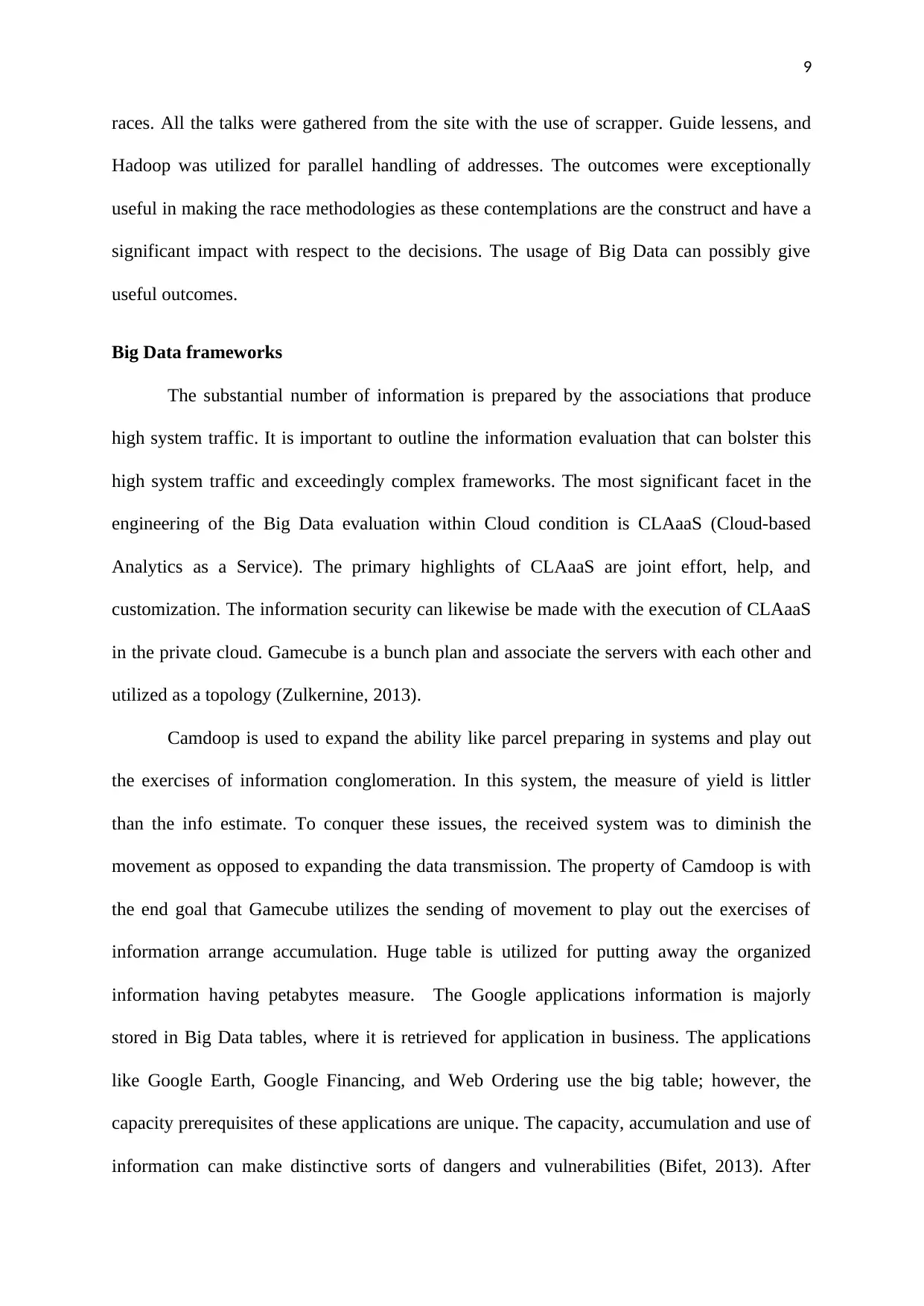
9
races. All the talks were gathered from the site with the use of scrapper. Guide lessens, and
Hadoop was utilized for parallel handling of addresses. The outcomes were exceptionally
useful in making the race methodologies as these contemplations are the construct and have a
significant impact with respect to the decisions. The usage of Big Data can possibly give
useful outcomes.
Big Data frameworks
The substantial number of information is prepared by the associations that produce
high system traffic. It is important to outline the information evaluation that can bolster this
high system traffic and exceedingly complex frameworks. The most significant facet in the
engineering of the Big Data evaluation within Cloud condition is CLAaaS (Cloud-based
Analytics as a Service). The primary highlights of CLAaaS are joint effort, help, and
customization. The information security can likewise be made with the execution of CLAaaS
in the private cloud. Gamecube is a bunch plan and associate the servers with each other and
utilized as a topology (Zulkernine, 2013).
Camdoop is used to expand the ability like parcel preparing in systems and play out
the exercises of information conglomeration. In this system, the measure of yield is littler
than the info estimate. To conquer these issues, the received system was to diminish the
movement as opposed to expanding the data transmission. The property of Camdoop is with
the end goal that Gamecube utilizes the sending of movement to play out the exercises of
information arrange accumulation. Huge table is utilized for putting away the organized
information having petabytes measure. The Google applications information is majorly
stored in Big Data tables, where it is retrieved for application in business. The applications
like Google Earth, Google Financing, and Web Ordering use the big table; however, the
capacity prerequisites of these applications are unique. The capacity, accumulation and use of
information can make distinctive sorts of dangers and vulnerabilities (Bifet, 2013). After
races. All the talks were gathered from the site with the use of scrapper. Guide lessens, and
Hadoop was utilized for parallel handling of addresses. The outcomes were exceptionally
useful in making the race methodologies as these contemplations are the construct and have a
significant impact with respect to the decisions. The usage of Big Data can possibly give
useful outcomes.
Big Data frameworks
The substantial number of information is prepared by the associations that produce
high system traffic. It is important to outline the information evaluation that can bolster this
high system traffic and exceedingly complex frameworks. The most significant facet in the
engineering of the Big Data evaluation within Cloud condition is CLAaaS (Cloud-based
Analytics as a Service). The primary highlights of CLAaaS are joint effort, help, and
customization. The information security can likewise be made with the execution of CLAaaS
in the private cloud. Gamecube is a bunch plan and associate the servers with each other and
utilized as a topology (Zulkernine, 2013).
Camdoop is used to expand the ability like parcel preparing in systems and play out
the exercises of information conglomeration. In this system, the measure of yield is littler
than the info estimate. To conquer these issues, the received system was to diminish the
movement as opposed to expanding the data transmission. The property of Camdoop is with
the end goal that Gamecube utilizes the sending of movement to play out the exercises of
information arrange accumulation. Huge table is utilized for putting away the organized
information having petabytes measure. The Google applications information is majorly
stored in Big Data tables, where it is retrieved for application in business. The applications
like Google Earth, Google Financing, and Web Ordering use the big table; however, the
capacity prerequisites of these applications are unique. The capacity, accumulation and use of
information can make distinctive sorts of dangers and vulnerabilities (Bifet, 2013). After
⊘ This is a preview!⊘
Do you want full access?
Subscribe today to unlock all pages.

Trusted by 1+ million students worldwide
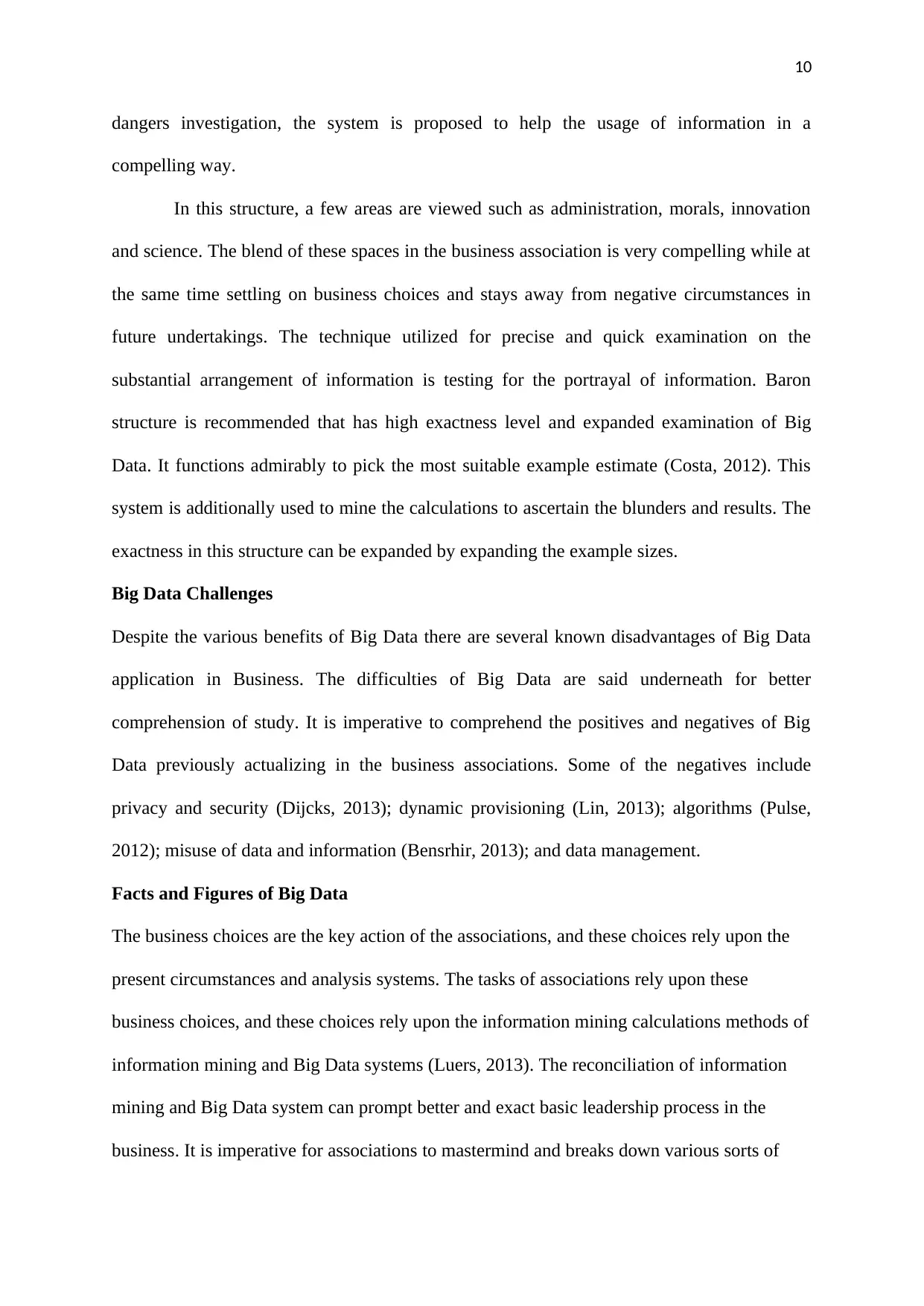
10
dangers investigation, the system is proposed to help the usage of information in a
compelling way.
In this structure, a few areas are viewed such as administration, morals, innovation
and science. The blend of these spaces in the business association is very compelling while at
the same time settling on business choices and stays away from negative circumstances in
future undertakings. The technique utilized for precise and quick examination on the
substantial arrangement of information is testing for the portrayal of information. Baron
structure is recommended that has high exactness level and expanded examination of Big
Data. It functions admirably to pick the most suitable example estimate (Costa, 2012). This
system is additionally used to mine the calculations to ascertain the blunders and results. The
exactness in this structure can be expanded by expanding the example sizes.
Big Data Challenges
Despite the various benefits of Big Data there are several known disadvantages of Big Data
application in Business. The difficulties of Big Data are said underneath for better
comprehension of study. It is imperative to comprehend the positives and negatives of Big
Data previously actualizing in the business associations. Some of the negatives include
privacy and security (Dijcks, 2013); dynamic provisioning (Lin, 2013); algorithms (Pulse,
2012); misuse of data and information (Bensrhir, 2013); and data management.
Facts and Figures of Big Data
The business choices are the key action of the associations, and these choices rely upon the
present circumstances and analysis systems. The tasks of associations rely upon these
business choices, and these choices rely upon the information mining calculations methods of
information mining and Big Data systems (Luers, 2013). The reconciliation of information
mining and Big Data system can prompt better and exact basic leadership process in the
business. It is imperative for associations to mastermind and breaks down various sorts of
dangers investigation, the system is proposed to help the usage of information in a
compelling way.
In this structure, a few areas are viewed such as administration, morals, innovation
and science. The blend of these spaces in the business association is very compelling while at
the same time settling on business choices and stays away from negative circumstances in
future undertakings. The technique utilized for precise and quick examination on the
substantial arrangement of information is testing for the portrayal of information. Baron
structure is recommended that has high exactness level and expanded examination of Big
Data. It functions admirably to pick the most suitable example estimate (Costa, 2012). This
system is additionally used to mine the calculations to ascertain the blunders and results. The
exactness in this structure can be expanded by expanding the example sizes.
Big Data Challenges
Despite the various benefits of Big Data there are several known disadvantages of Big Data
application in Business. The difficulties of Big Data are said underneath for better
comprehension of study. It is imperative to comprehend the positives and negatives of Big
Data previously actualizing in the business associations. Some of the negatives include
privacy and security (Dijcks, 2013); dynamic provisioning (Lin, 2013); algorithms (Pulse,
2012); misuse of data and information (Bensrhir, 2013); and data management.
Facts and Figures of Big Data
The business choices are the key action of the associations, and these choices rely upon the
present circumstances and analysis systems. The tasks of associations rely upon these
business choices, and these choices rely upon the information mining calculations methods of
information mining and Big Data systems (Luers, 2013). The reconciliation of information
mining and Big Data system can prompt better and exact basic leadership process in the
business. It is imperative for associations to mastermind and breaks down various sorts of
Paraphrase This Document
Need a fresh take? Get an instant paraphrase of this document with our AI Paraphraser
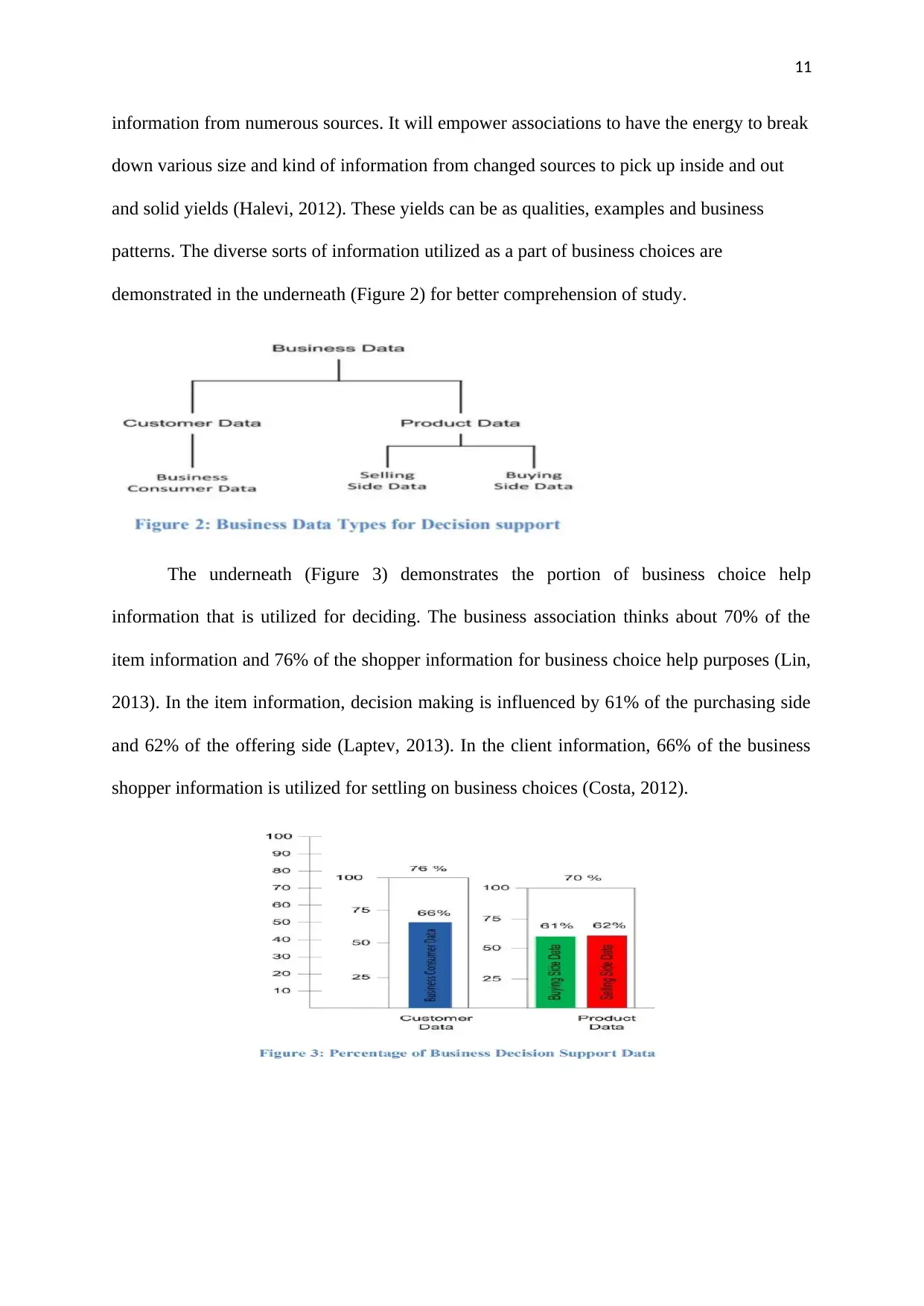
11
information from numerous sources. It will empower associations to have the energy to break
down various size and kind of information from changed sources to pick up inside and out
and solid yields (Halevi, 2012). These yields can be as qualities, examples and business
patterns. The diverse sorts of information utilized as a part of business choices are
demonstrated in the underneath (Figure 2) for better comprehension of study.
The underneath (Figure 3) demonstrates the portion of business choice help
information that is utilized for deciding. The business association thinks about 70% of the
item information and 76% of the shopper information for business choice help purposes (Lin,
2013). In the item information, decision making is influenced by 61% of the purchasing side
and 62% of the offering side (Laptev, 2013). In the client information, 66% of the business
shopper information is utilized for settling on business choices (Costa, 2012).
information from numerous sources. It will empower associations to have the energy to break
down various size and kind of information from changed sources to pick up inside and out
and solid yields (Halevi, 2012). These yields can be as qualities, examples and business
patterns. The diverse sorts of information utilized as a part of business choices are
demonstrated in the underneath (Figure 2) for better comprehension of study.
The underneath (Figure 3) demonstrates the portion of business choice help
information that is utilized for deciding. The business association thinks about 70% of the
item information and 76% of the shopper information for business choice help purposes (Lin,
2013). In the item information, decision making is influenced by 61% of the purchasing side
and 62% of the offering side (Laptev, 2013). In the client information, 66% of the business
shopper information is utilized for settling on business choices (Costa, 2012).
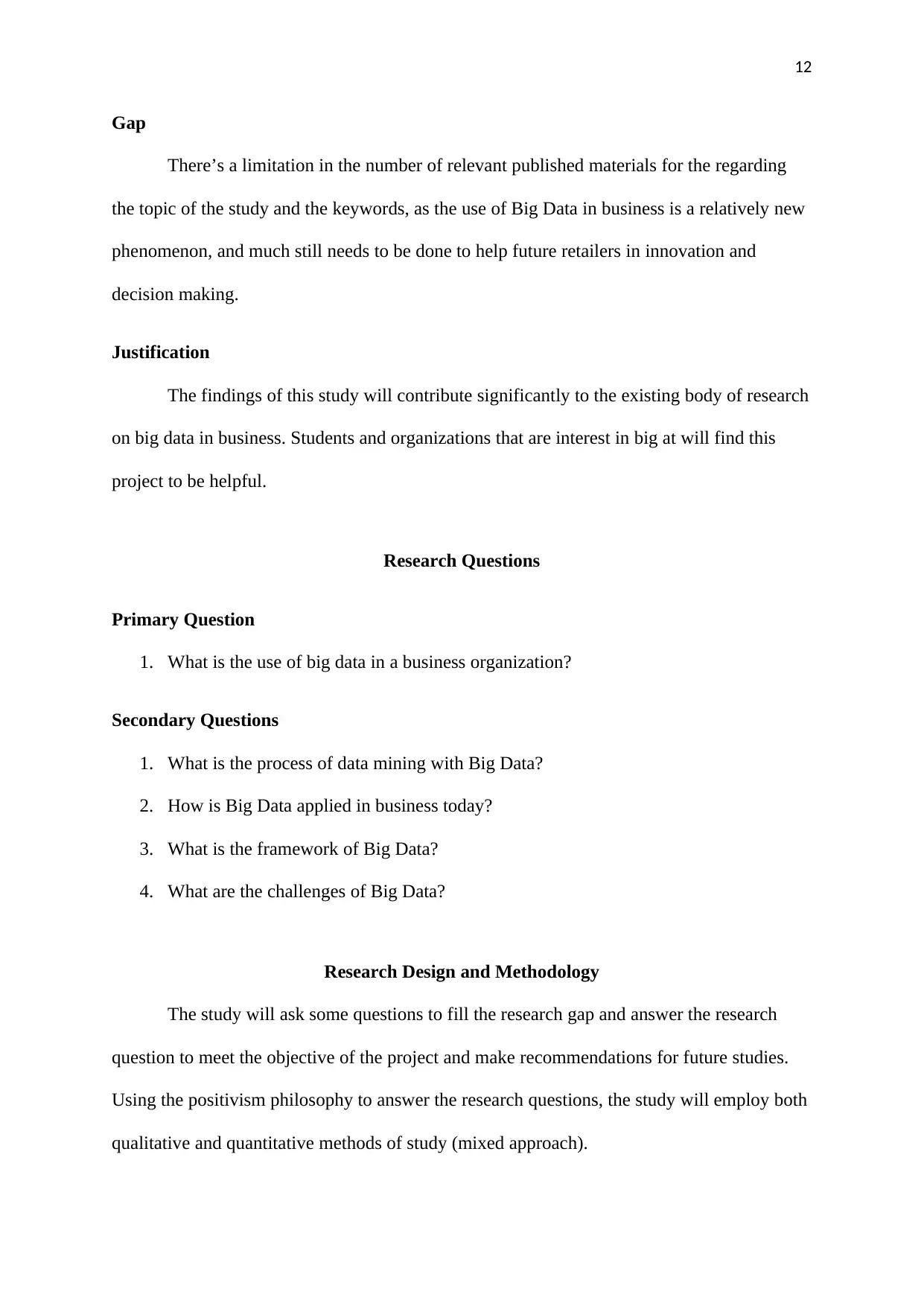
12
Gap
There’s a limitation in the number of relevant published materials for the regarding
the topic of the study and the keywords, as the use of Big Data in business is a relatively new
phenomenon, and much still needs to be done to help future retailers in innovation and
decision making.
Justification
The findings of this study will contribute significantly to the existing body of research
on big data in business. Students and organizations that are interest in big at will find this
project to be helpful.
Research Questions
Primary Question
1. What is the use of big data in a business organization?
Secondary Questions
1. What is the process of data mining with Big Data?
2. How is Big Data applied in business today?
3. What is the framework of Big Data?
4. What are the challenges of Big Data?
Research Design and Methodology
The study will ask some questions to fill the research gap and answer the research
question to meet the objective of the project and make recommendations for future studies.
Using the positivism philosophy to answer the research questions, the study will employ both
qualitative and quantitative methods of study (mixed approach).
Gap
There’s a limitation in the number of relevant published materials for the regarding
the topic of the study and the keywords, as the use of Big Data in business is a relatively new
phenomenon, and much still needs to be done to help future retailers in innovation and
decision making.
Justification
The findings of this study will contribute significantly to the existing body of research
on big data in business. Students and organizations that are interest in big at will find this
project to be helpful.
Research Questions
Primary Question
1. What is the use of big data in a business organization?
Secondary Questions
1. What is the process of data mining with Big Data?
2. How is Big Data applied in business today?
3. What is the framework of Big Data?
4. What are the challenges of Big Data?
Research Design and Methodology
The study will ask some questions to fill the research gap and answer the research
question to meet the objective of the project and make recommendations for future studies.
Using the positivism philosophy to answer the research questions, the study will employ both
qualitative and quantitative methods of study (mixed approach).
⊘ This is a preview!⊘
Do you want full access?
Subscribe today to unlock all pages.

Trusted by 1+ million students worldwide
1 out of 18
Related Documents
Your All-in-One AI-Powered Toolkit for Academic Success.
+13062052269
info@desklib.com
Available 24*7 on WhatsApp / Email
![[object Object]](/_next/static/media/star-bottom.7253800d.svg)
Unlock your academic potential
Copyright © 2020–2025 A2Z Services. All Rights Reserved. Developed and managed by ZUCOL.





